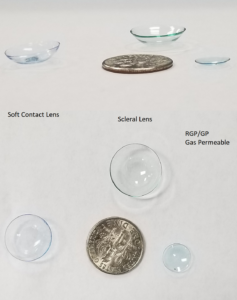What are Scleral Lenses?
Scleral contact lenses are a type of gas-permeable contact lens that is larger in diameter than traditional contact lenses. They cover the entire cornea and rest on the sclera, the white part of the eye. Scleral lenses are filled with saline solution before insertion, which provides a cushion between the lens and the eye.
Scleral lenses are often used to correct vision problems in people with irregular corneas, such as those with keratoconus, corneal scarring, or other corneal irregularities. They can also be used in people with severe dry eye syndrome or other conditions that make wearing traditional contact lenses uncomfortable or impossible. Scleral lenses are the largest type of contact lens but come in semi-scleral, mini-scleral, and full scleral; from smallest to largest.

Conditions That Need Scleral Lenses
- Keratoconus: Keratoconus is a progressive eye disease that causes the cornea to thin and bulge into a cone-like shape. This irregular shape can cause significant vision problems, including astigmatism and nearsightedness. Scleral lenses can help to correct vision by providing a smooth surface over the cornea.
- Corneal Scarring: Corneal scarring can occur as a result of injury, infection, or inflammation. Scarring can cause irregularities in the cornea that make it difficult to achieve clear vision with traditional contact lenses or glasses. Scleral lenses can help to provide a smooth surface over the cornea, improving vision in people with corneal scarring.
- Severe Dry Eye Syndrome: Severe dry eye syndrome can make it difficult to wear traditional contact lenses or even glasses comfortably. Scleral lenses can help by creating a reservoir of saline solution that keeps the eye hydrated throughout the day.
- Neurotrophic keratitis: Neurotrophic keratitis is a rare condition that affects the cornea, the clear outer layer of the eye. This condition is caused by damage to the trigeminal nerve, which is responsible for providing sensation to the cornea. When this nerve is damaged, the cornea can become numb and lose its ability to heal properly, leading to a range of corneal issues. These can include persistent epithelial defects, corneal thinning, and corneal ulceration, which can cause vision loss if left untreated. Treatment for neurotrophic keratitis typically involves a combination of medication, such as artificial tears or ointments, and in severe cases, surgical intervention. Close monitoring and prompt treatment are important to prevent further damage to the cornea and preserve vision.
- Pellucid Marginal Degeneration: Pellucid Marginal Degeneration (PMD) is a rare condition that affects the cornea and causes it to thin and bulge. This thinning and bulging typically occur in a specific region of the cornea, known as the pellucid or limbal area. PMD can cause significant corneal issues, including irregular astigmatism, blurry or distorted vision, and increased sensitivity to light. PMD typically affects both eyes, and the severity can vary between individuals. Treatment for PMD typically involves the use of specialized contact lenses, such as scleral or gas-permeable lenses, to correct vision and provide a smooth surface for the cornea. In severe cases, corneal transplantation may be necessary to restore vision. Regular monitoring is important for individuals with PMD to ensure that any changes in vision or corneal shape are detected early and treated promptly.
Scleral Lens Fitting
Scleral lens fitting is a specialized process that requires expertise and experience. Dr. Robin Greenfield has years of experience fitting scleral lenses for a wide range of conditions. During the fitting process, we will take detailed measurements of your eye and cornea to ensure that the lenses fit comfortably and provide clear vision. This is done with the assistance of a topographer which will map the front surface of the eye.
If you think you may benefit from scleral lenses, we encourage you to schedule an exam. We will work with you to determine if scleral lenses are the right choice for your needs and provide you with the best care and expertise available.
Scleral contact lenses are a valuable tool in correcting vision problems for people with irregular corneas, severe dry eye syndrome, and other conditions that make wearing traditional contact lenses difficult or impossible. Our team of optometrists has the expertise and experience necessary to fit scleral lenses for a wide range of conditions, and we encourage you to schedule a consultation to learn more about how scleral lenses can help improve your vision and quality of life.
Is it covered by insurance?
Typically, if you have a vision plan, there is likely a benefit known as “Medically Necessary Contact Lenses” according to Eyemed or “Visually Necessary Contact Lenses” according to VSP. Most insurances use the “Medically Necessary Contact Lens” name for the benefit. It is important to determine this ahead of time as scleral lens fittings are the most involved and knowing that insurance covers it and by how much is important. Sometimes an insurance company will ask for codes. The following codes are as follows:
- 92310 or 92072 is the CPT/HCPS or otherwise known as the procedure code. This needs to be accompanied by an ICD-10 diagnosis code for example:
- Keratoconus-unspecified: H18.601
- Pellucid Margin Degeneration-bilateral: H18.713
- Corneal Scar-bilateral: H17.13
- Neurotrophic keratitis-bilateral: H16.233
In general, providing a code with either of the two procedure codes will help the insurance plan locate the benefit. It’s important to note that the diagnosis code is the important part of the question as most insurances will usually not cover routine contact lens fittings. Merely asking if they cover the procedure will usually end up with a “no” from the insurance company. Please contact our office if we can be of any assistance.
